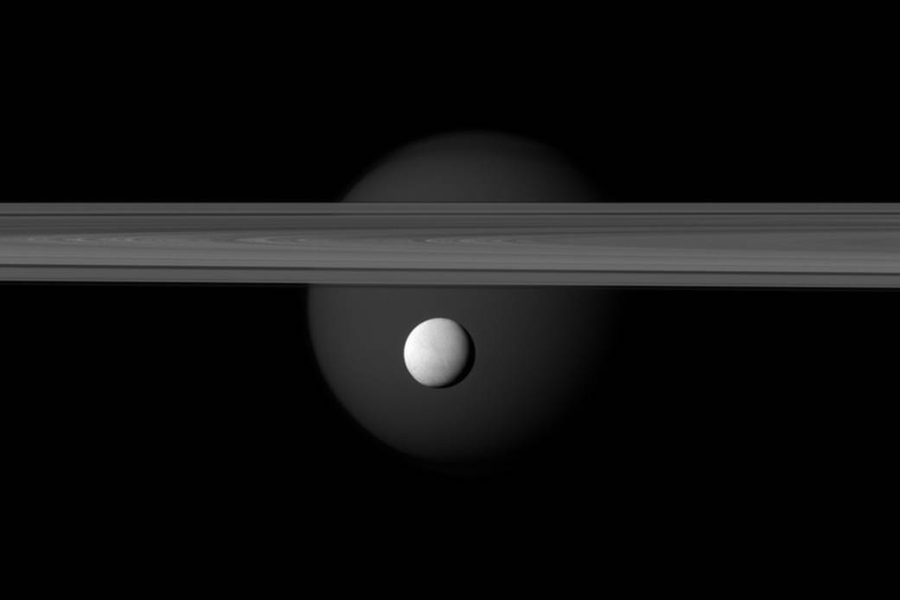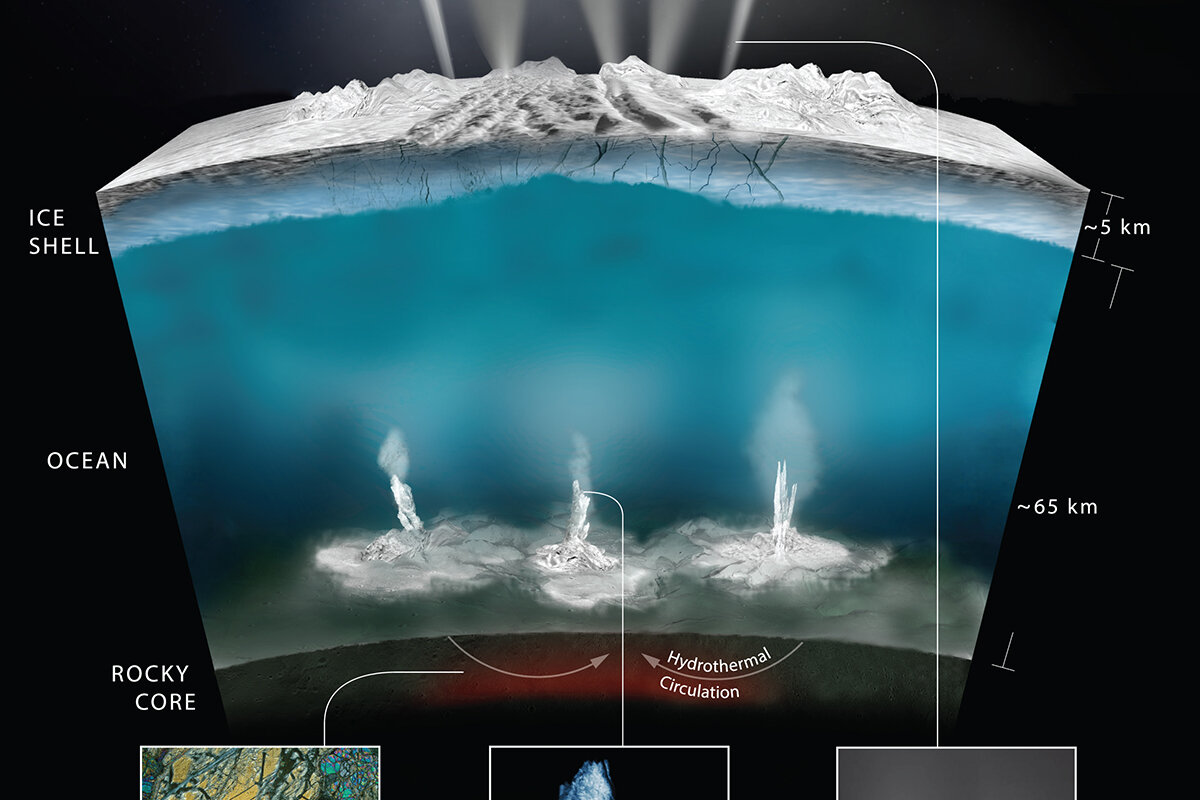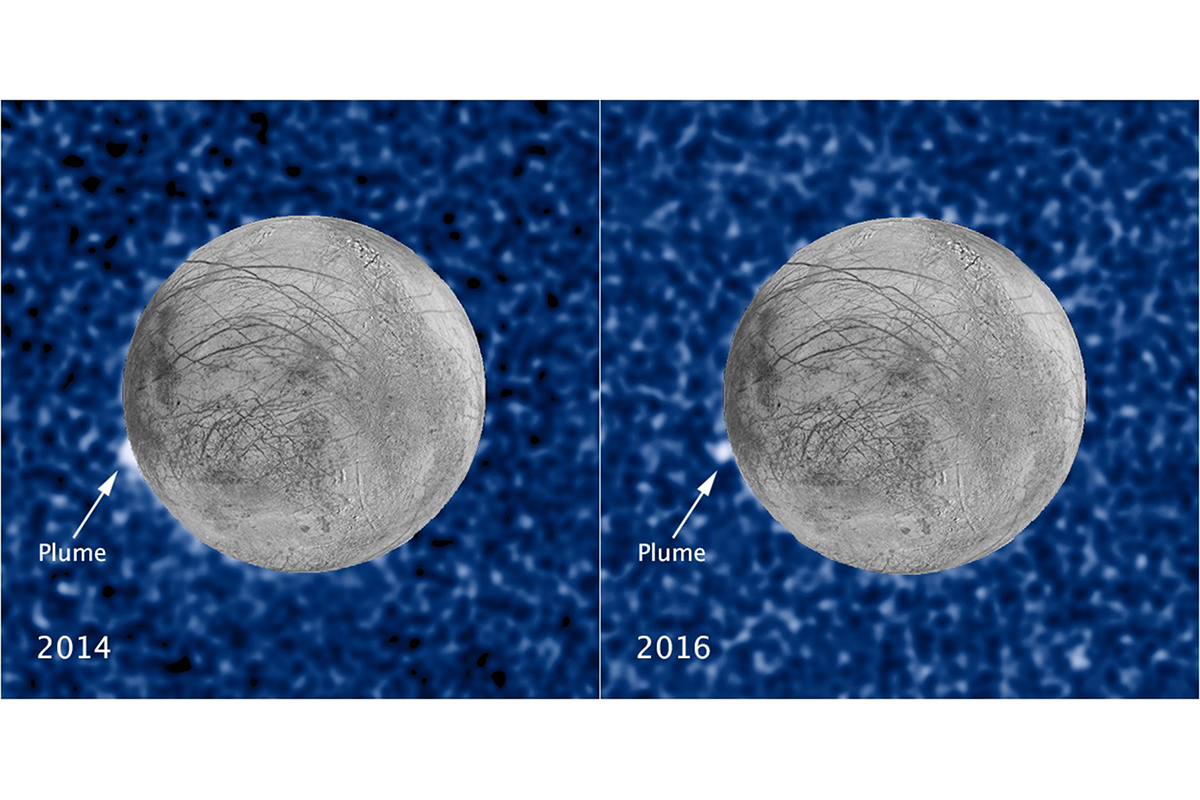Enceladus ocean jets spew hydrogen: Hint of life?
Loading...
Step aside freezing Martian deserts. The pitch black seas of at least one of the solar system’s far-flung water worlds has nearly everything needed for life, NASA says.
The Cassini spacecraft has detected molecular hydrogen on Saturn’s moon Enceladus, a potential energy source for rare forms of life much like those found near Earth’s deep sea vents, according to a paper published Thursday in the journal Science and a NASA press conference. This detection adds to the growing list of ingredients for life found on the icy moon.
But Enceladus isn’t the only one of our solar system’s icy moons sparking excitement at NASA.
NASA scientists also announced that what appear to be water plumes spewing out of Jupiter’s moon Europa have been spotted using the Hubble Space Telescope, again.
Together, the two announcements paint a picture of two water worlds protected by ice and fueled by warm cores. And, as these moons have surprised scientists, they could redefine how scientists think about the habitability of the solar system and hunt for alien life.
“With this research, we’re making a big step forward towards answering the question: ‘Is there life out there?’ ” Thomas Zurbuchen, associate administrator of NASA’s Science Mission Directorate, said during the press conference.
The search for life in the solar system starts at home, which means water. “The one kind of life that we know about, which is life on Earth, requires liquid water,” explains Jonathan Lunine, an astrophysicist at Cornell University in New York and a co-author on the Science paper. “The one common denominator of every form of life on Earth is that it requires liquid water to live.”
Besides the wet stuff, life also needs an energy source (aka food), and the right chemical ingredients to make an organism, namely carbon, hydrogen, nitrogen, oxygen, phosphorus, and sulfur. Firm answers for Jupiter's moon will have to wait for NASA’s Europa Clipper mission, slated for the 2020s. But Cassini has provided the strongest evidence yet that Enceladus has what it takes in what Cassini project scientist Linda Spilker called “a capstone finding for the mission.” The final holdouts are phosphorus and sulfur, which scientists suspect exist in the moon's core.
A new Goldilocks zone
The search for extraterrestrial life has long focused on so-called Goldilocks zones, the area around a star with just enough energy to melt surface ice without boiling surface water. Jupiter and Saturn sit outside this zone, where it’s too dark and cold for the sun to make liquid water stable on the surface of any planet or moon.
But sunlight isn’t the only source of heat. Gravity is an option too.
As the moon creates tides on Earth by gravitationally tugging on the nearside more than the far side, resulting in the two bodies stretching each other as they orbit, Saturn and Jupiter also pull at their moons.
Saturn similarly churns Enceladus’s core by “as much as 90 feet every two to three days,” according to Jim Green, NASA’s director of Planetary Science Division. This motion generates the energy needed to power hot water vents where ocean meets rock, playing the role drifting continents do on Earth and giving rise to a new Goldilocks zone sandwiched between fire and ice.
And yet, nothing can live on heat and water alone. You also need food, and almost all Earth-life ultimately runs on sunlight. Plants form the foundation of land based food chains while photosynthesis-capable phytoplankton support those of the ocean. Even beings lurking in dark depths benefit from scavenging what sinks from the surface.
It wasn’t until the late '70s that science discovered life had found another energy source: chemicals. Holes in the sea floor spewing molecule-rich jets of hot water known as hydrothermal vents turned out to house whole ecosystems thriving in perfect darkness.
So-called chemosynthetic microbes underpin these webs of life, underscoring biology’s broad resilience and opening the door to the possibility of life on harsh moons of the outer solar system, where dozens of miles of ice keep oceans even darker than their terrestrial counterparts.
“The Enceladus case is a perfect example of how these amazing discoveries that Cassini is making really require an understanding of, in this case, what's going on at the bottom of Earth's oceans to be able to interpret,” Dr. Lunine says. And without that data, “We really wouldn't be able to interpret what we're seeing for Enceladus.”
Cassini has been gradually building the case for habitability during its nearly 13 years in the Saturn system, revealing tantalizing hints of vent activity via silica it sniffed with its instruments during repeated dives through Enceladus’s icy plumes. Now the discovery of molecular hydrogen supplies the last piece of the puzzle, confirming that the moon’s floor has all the same elements as certain microbe friendly vents on Earth, such as the Atlantic Ocean’s “Lost City.”
“The big question was [hydrogen], so the confirmation of [hydrogen] in the plume is very important and confirms that the ocean of Enceladus would be a nice place for life, methanogens in particular,” writes Chris McKay, a NASA Ames Research Center astrobiologist who was not involved with the paper, in an email.
Methanogens are microbes that process hydrogen and carbon dioxide for energy, giving off methane. Cassini has also detected methane in the ice plumes, and while non-biological sources of methane are still possible, this discovery of hydrogen supplies another intriguing piece of the puzzle.
The team considered other sources besides the vents, but concluded that the moon is too small to have attracted hydrogen with its gravity and held onto it for hundreds of millions of years, leaving vents as the only remaining option.
"I think that Cassini has pretty much put the nail in the ocean on this one and the Enceladus ocean is habitable," says Lunine.
Questions remain
But don’t start planning your Enceladus fishing trip just yet. While the presence of hydrogen is exciting, its abundance is almost concerning. If there’s something swimming around down there, it isn’t very hungry. “We have this buildup of food that’s not being used,” said NASA astrobiologist Mary Voytek during the press conference. “My money for the moment is still on Europa, but it still could be on any of these moons.”
Furthermore, not everyone agrees that the discovery of molecular hydrogen on Enceladus means the moon is certainly habitable.
"I would say that it is definitely a possibility, but to say straight out that it is a habitable environment is maybe going a little bit too far," as habitability requires more than just energy and water, Alexandra Pontefract, a geomicrobiologist at MIT who was not involved in the research, says in a phone interview.
"It would also be incredibly interesting to understand how life could have arisen in such an environment," she adds. "On Earth, though vent systems have long been the focus of origins of life research, we have yet to adequately explain how RNA and DNA (the basis for heredity) could be synthesized" in such a wet environment. As far as scientists know, the chemical soup needs to dry out for the chemistry to be catalyzed to form these key molecules.
But, Dr. Pontefract says, the detection of molecular hydrogen does raise the possibility that there could be a food source for microbial life deep in Enceladus’ oceans. "Enceladus represents a really fantastic target for life detection within our solar system," she says.
This finding of molecular hydrogen in Enceladus’s plumes comes just as the Cassini mission is coming to a close. The mission will conclude as the spacecraft, which was launched in October 1997, will dip into Saturn’s atmosphere in September where extreme pressure and heat will permanently retire the craft.
Cassini’s instruments aren’t up to the task of detecting life directly, so more answers about the water worlds will have to wait for upgraded toys on future missions.
As for Europa, it won’t be long until scientists are able to take a closer look at what NASA is now almost completely certain are water plumes, after observing repeated bursts in the same location. The agency plans to launch a spacecraft to that icy moon of Jupiter in the early 2020s. The Europa Clipper, as the mission has been named, will point cameras and spectrometers at the moon to study its icy crust and search for subsurface lakes and oceans that are suspected to be fueling icy plumes.
By that time Cassini will be long gone, but the Clipper will continue its mission of probing these alien water worlds, probing our fundamental questions about life of both the terrestrial and extraterrestrial varieties.
“[These missions] are an expression of our human desire to explore in a peaceful way, our ability to create marvelous machines that can be our proxies all the way across the solar system,” says Lunine.
[Editor's note: This article has been updated to clarify Alexandra Pontefract's comments.]









